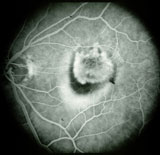Age-related Macular Degeneration
 Age-related macular degeneration is a painless disease which causes visual loss in older persons. The extent of visual loss is variable and most patients with macular degeneration do not have severe visual loss. Macular degeneration is named for the macula which is the part of the retina responsible for central vision. The remainder of the retina gives peripheral or "side" vision. Macular degeneration causes decreased central or reading vision but usually does not affect peripheral vision. Macular degeneration is the most frequent cause of severe visual loss in persons over age 65 and the risk of developing macular degeneration increases with age. Macular degeneration does not cause complete blindness and most persons with macular degeneration retain enough vision to be able to care for themselves and walk around without assistance.
Age-related macular degeneration is a painless disease which causes visual loss in older persons. The extent of visual loss is variable and most patients with macular degeneration do not have severe visual loss. Macular degeneration is named for the macula which is the part of the retina responsible for central vision. The remainder of the retina gives peripheral or "side" vision. Macular degeneration causes decreased central or reading vision but usually does not affect peripheral vision. Macular degeneration is the most frequent cause of severe visual loss in persons over age 65 and the risk of developing macular degeneration increases with age. Macular degeneration does not cause complete blindness and most persons with macular degeneration retain enough vision to be able to care for themselves and walk around without assistance.
Symptoms
 The symptoms of macular degeneration include blurred, dim or distorted vision. Some persons note a black spot in front of their central vision. Central vision is essential to allow people to read and drive so macular degeneration may be first recognized by difficulty reading or difficulty reading road signs while driving. Most macular degeneration has a gradual onset and many patients don't realize they are losing vision. The symptoms usually develop first in one eye so unfortunately the symptoms of macular degeneration are often missed until a person covers the unaffected eye. Loss of central vision in one or both eyes should result in a prompt visit to your eye doctor. The following test will help you determine if you may have macular degeneration.
The symptoms of macular degeneration include blurred, dim or distorted vision. Some persons note a black spot in front of their central vision. Central vision is essential to allow people to read and drive so macular degeneration may be first recognized by difficulty reading or difficulty reading road signs while driving. Most macular degeneration has a gradual onset and many patients don't realize they are losing vision. The symptoms usually develop first in one eye so unfortunately the symptoms of macular degeneration are often missed until a person covers the unaffected eye. Loss of central vision in one or both eyes should result in a prompt visit to your eye doctor. The following test will help you determine if you may have macular degeneration.
Testing for macular degeneration
- Cover the left eye and look at center of the grid using your reading glasses at a comfortable reading distance.
- The lines should be straight and you should be able to see the dot in the center of the grid.
- Repeat the test by covering the right eye.
- Distortion of the lines on the grid or blurring of the grid may be a symptom of macular degeneration.
You should be examined by your eye doctor if there is new or increased distortion or blurring of the grid.
Types of macular degeneration
The cause of macular degeneration is not very well understood but it is known that it relates to aging in specific layers of the retina. There are two forms of macular degeneration which are called atrophic ("dry") and exudative ("wet"). Both forms can cause decreased vision but the wet type usually causes more severe and more rapid visual loss. About 90% of persons with macular degeneration have the dry type while the remaining 10% have wet macular degeneration. Most persons diagnosed with dry macular degeneration will continue to have dry macular degeneration although dry macular degeneration may evolve into wet macular degeneration.
Treatment
There is a large research effort being devoted to try to improve treatment of dry and wet macular degeneration since it is becoming a greater public health problem as life expectancy increases. There are few treatments for dry macular degeneration but a study called the Age-Related Eye Disease Study (AREDS) found that certain anti-oxidants (Vitamin A or lutein/zeaxanthin, C and E) and minerals (zinc and copper) helps to slow the progression of dry macular degeneration once it reaches an intermediate stage. Wet macular degeneration may be treated with laser photocoagulation in some eyes although laser is not beneficial in several subtypes of wet macular degeneration. Laser photocoagulation focuses a very intense light and closes areas of leakage associated with wet macular degeneration. Laser photocoagulation is very useful in eyes where the source of the leakage is outside of the center of vision. If the leakage in under the center of vision, another approach must be considered. A new class of drugs called anti-VEGF (anti-vascular endothelial growth factor) are being injected into the vitreous cavity. These drugs include ranibizumab (Lucentis®), alfibercept (Eylea®) or bevacizumab (Avastin®). These drugs are injected into the center of the eye and help to make the abnormal blood vessels in the outer retina recede which can lead to improved vision or prevent further loss of vision. All of the existing therapies for wet macular degeneration appear to work best if they are performed earlier in the course of the disease, when leakage is localized. Hence, early detection is the most important goal to preserve vision from macular degeneration. Increased public awareness about the symptoms of macular degeneration will help to prevent unnecessary visual loss from this disease.
